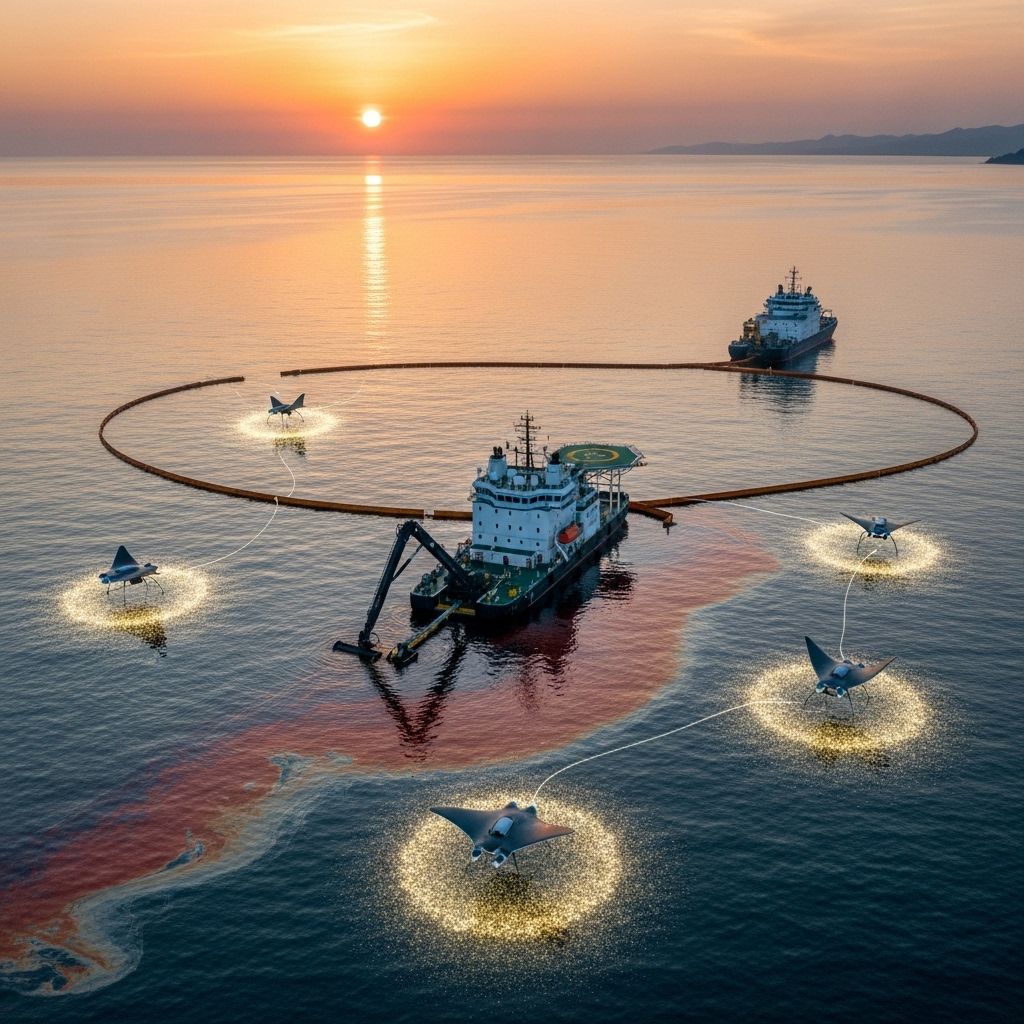New Frontiers in Oil Spill Cleanup: Breakthrough Technologies of the Last Five Years
Explore the cutting-edge technologies revolutionizing oil spill cleanup, minimizing environmental impact, and protecting marine ecosystems.

Oil spills have long been one of the most devastating forms of marine pollution, causing irreparable harm to ocean ecosystems, coastal communities, and global biodiversity. The catastrophic effects of the Deepwater Horizon spill in 2010 served as a clarion call for new solutions, inspiring a wave of scientific innovation. In just the last five years, researchers and engineers have introduced an impressive array of technologies that promise to revolutionize the way we respond to oil spills—dramatically improving speed, efficiency, and environmental safety.
Why Oil Spills Demand Cutting-Edge Cleanup Solutions
Traditional oil spill remediation approaches—mechanical, chemical, and physical—have often struggled with limitations such as inefficiency, environmental harm, and slow response times. Products like skimmers, chemical dispersants, and sorbents may be effective in limited conditions, but can fail to fully remove oil or introduce secondary pollution. The gravity of oil spills, both large and small, has spurred investment in technologies that are faster, cleaner, and more sustainable.
- Mechanical Skimming: Uses floating barriers and collection devices, effective only with thick surface slicks and calm seas.
- Chemical Dispersants: Break oil into small droplets, but their toxicity poses risks to marine life and coastal habitats.
- Burning and Absorbents: Can remove oil quickly but generate air pollution or waste.
To address these shortcomings, recent innovations combine material science, nanotechnology, and biomimicry to deliver transformative results.
Breakthrough 1: Dual-Layer Mesh Roller with Induction Heating
One groundbreaking advance is the dual-layer mesh roller developed by researchers at the University of Texas at Austin. This ingenious device is engineered to outperform conventional cleanup by orders of magnitude.
- How It Works: The roller uses a gel-coated dual-layer mesh. The bottom layer captures oil from the water interface, while the top layer, heated by non-contact induction, enhances the separation of oil from water even for highly viscous crude.
- Record Efficiency: Laboratory tests demonstrate the capability to remove up to 1,400 kg of oil per square meter per hour—a tenfold improvement over most existing technologies.
- Reusable Oil: With more than 99% oil-water separation efficiency, the technique allows for captured oil to be recycled and reused rather than wasted.
This roller can be deployed in various sizes, enabling robust coverage of spill areas in a matter of days rather than weeks. The rapid, selective recovery of oil minimizes secondary environmental impacts and sets a new standard for eco-friendly response.
Breakthrough 2: The Magnetic Nanocomposite “Smart Sponge”
Developed at Northwestern University, the so-called “smart sponge” marks a leap forward in absorbing and recovering oil without disrupting marine life.
- Selective Absorption: Coated in an oleophilic (oil-attracting), hydrophobic (water-repellent), and magnetic nanocomposite, the sponge soaks up over 30 times its weight in oil while ignoring water.
- Reusability: After oil is extracted, the sponge can be reused dozens of times with negligible loss in performance.
- Minimal Environmental Impact: The sponge leaves behind clean water and protects marine life, avoiding the chemical and waste issues of earlier absorbents.
- Magnetic Retrieval: The magnetic properties allow remote or targeted cleanup when controlled by an external field, useful for inaccessible or sensitive habitats.
Real-world tests showed that even under simulated wave conditions, the smart sponge retained nearly all collected oil. The versatility of the nanocoating means this technology could evolve to tackle other pollutants in water, soil, and air.
Breakthrough 3: Nano-Enhanced Bioremediation
Sustainable, nature-inspired bioremediation—the use of microorganisms to digest and break down oil—has been transformed by nanotechnology. Over the past five years, research has focused on enhancing indigenous microbes’ effectiveness with specialized nanoparticles.
- Broad Application: Nano-enhanced methods are versatile, working with varied oil types and under different environmental conditions.
- Eco-Friendly: Unlike chemical dispersants or burning, bioremediation leaves no harmful residues and restores ecological balance.
- Lab to Field: While most studies remain laboratory-based, large-scale experiments simulating natural ecosystems are moving these methods closer to practical deployment.
| Technology | Efficiency | Reuse | Environmental Impact |
|---|---|---|---|
| Dual-layer mesh roller | 10× current methods | Yes | Low, oil recyclable |
| Smart sponge | 30× absorbent weight | Dozens of cycles | Minimal, selective |
| Nano-bioremediation | Varied, depends on application | No direct reuse | Very low |
Breakthrough 4: Alternative Sorbent Materials and Bio-Inspired Solutions
Further innovation in the past five years includes new sorbents inspired by natural materials, such as mussel proteins or lotus leaves, and by the use of cellulose aerogels, carbon nanotubes, and biosurfactants.
- Bio-based Aerogels: Made from cellulose, these ultralight, porous materials absorb oil efficiently and degrade naturally.
- Superhydrophobic Coatings: Mimicking lotus leaf surfaces, these coatings repel water while attracting oil, making collection fast and selective.
- Biosurfactants: Produced by engineered microbes, these molecules break up oil slicks for microbial degradation without toxic chemicals.
Many of these new sorbents excel in cold water, thin oil films, and rough seas, where earlier products failed. Their lightweight, scalable design allows mass deployment across diverse aquatic conditions.
Current Challenges and the Path Ahead
While recent years have seen dramatic advances, scaling these technologies to address massive, real-world oil spills remains a major challenge.
- Cost and Manufacturing: Production of advanced materials, especially nanostructured or bio-based products, can be expensive or require specialized facilities.
- Environmental Safety: Long-term impacts of nanomaterials and new chemicals must be continually evaluated to ensure no new risks to ecosystems.
- Regulatory Hurdles: Approval for use of new methods, particularly those involving nanoparticles or genetically modified organisms, is closely regulated and requires extensive field data.
The future will likely blend these advances, deploying hybrid solutions that combine rapid mechanical removal, targeted absorbents, and eco-friendly bioremediation in a coordinated response.
FAQs on Oil Spill Cleanup Technologies
Q: Why are traditional oil spill cleanup methods insufficient?
A: Legacy methods such as mechanical skimmers, chemical dispersants, and burning can be slow, inefficient, and may introduce toxic byproducts that harm marine environments. They often fail under adverse conditions, such as high waves or thin oil films.
Q: How do new sorbents like the smart sponge improve upon the past?
A: New sorbents leverage magnetic, hydrophobic, and oleophilic properties to rapidly target and remove oil with minimal waste. They can be reused, dramatically decreasing both environmental impact and operating costs.
Q: What are the environmental benefits of nano-enhanced bioremediation?
A: By assisting natural microbial communities with tailored nanoparticles, these methods accelerate oil breakdown while keeping toxic residues to a minimum, promoting true ecosystem recovery.
Q: Have any of these technologies been deployed in real oil spills?
A: Most innovations have undergone rigorous laboratory and controlled condition testing. While field-scale deployments are imminent for some—such as improved mesh rollers and smart sponges—wide-scale implementation will depend on regulatory approval and large-scale manufacturing capabilities.
Q: Could these technologies be adapted for other types of pollution?
A: Yes. The principles behind selective absorption, smart materials, and enhanced bioremediation can be engineered to target heavy metals, nutrient runoff, or industrial toxins in a range of environments.
Key Takeaways
- Recent years have brought remarkable progress in oil spill remediation, fueled by nanotechnology, advanced materials, and nature-inspired innovation.
- New dual-layer mesh rollers, magnetic “smart sponges,” and nano-enhanced bioremediation set new standards for efficiency, speed, and sustainability in oil spill response.
- Challenges remain in scaling these methods for global deployment, but hybrid approaches promise a powerful, greener future for marine crisis response.
Frequently Asked Questions (FAQs)
Q: Can smart sponges be used more than once?
A: Yes, they can be reused dozens of times without significant loss of absorption power and can be tailored for varied pollutants.
Q: Are these technologies safe for marine life?
A: The latest methods, particularly advanced sorbents and bioremediation, are designed to leave clean water behind and minimize toxic residues, though long-term impact studies are ongoing.
Q: What is the main barrier to widespread adoption?
A: The chief obstacles include the cost and complexity of manufacturing high-tech materials at scale, obtaining regulatory approval, and confirming safety in real marine environments.
References
- https://cockrell.utexas.edu/news/breakthrough-oil-capturing-technology-offers-10x-improvement-cleaning-up-hazardous-spills/
- https://news.northwestern.edu/stories/2020/05/smart-sponge-could-clean-up-oil-spills/
- https://pubs.acs.org/doi/10.1021/acsestengg.0c00217
- https://pubs.acs.org/doi/10.1021/es2013227
- https://en.wikipedia.org/wiki/Refugio_oil_spill
Read full bio of medha deb












